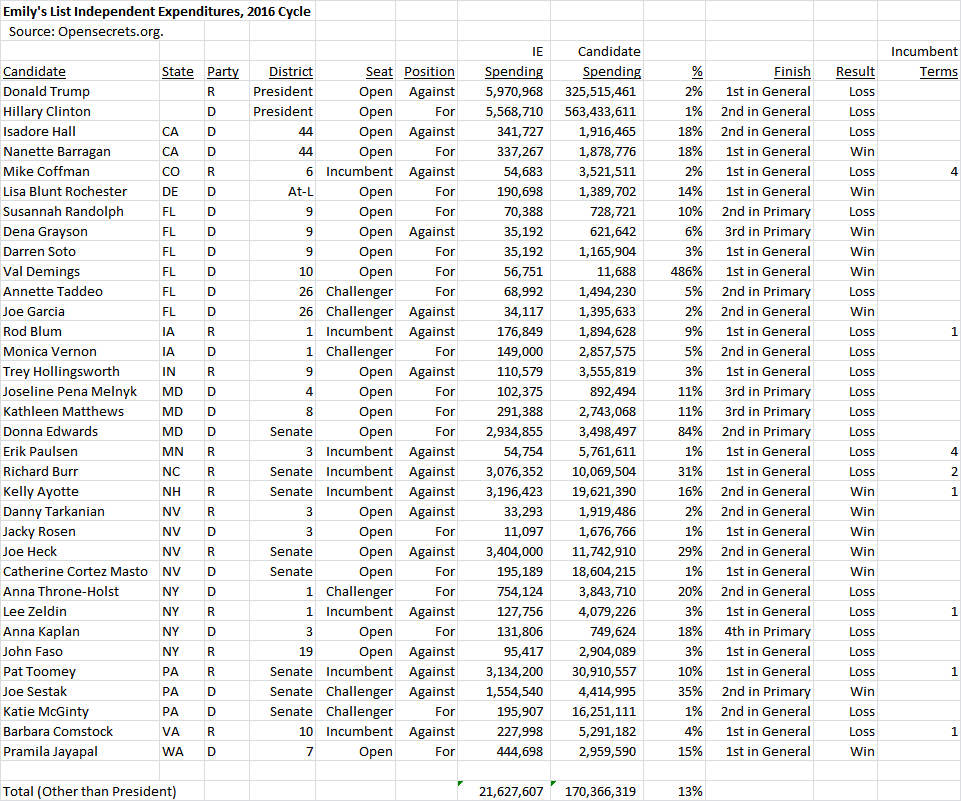By Adam Pagnucco.
Recently, Emily’s List announced its endorsement for CD6 candidate Aruna Miller, a move seen as significant in that race. Emily’s List’s Super PAC, Women Vote, has made millions of dollars in independent expenditures (IE) in federal races over the last five cycles. But how effective are they?
Let’s start in Maryland. In 2016, Emily’s List invested in three federal candidates: Donna Edwards (U.S. Senate), Joseline Peña-Melnyk (CD 4) and Kathleen Matthews (CD8). The group had an impact: they accounted for at least a million dollars in TV spending for Edwards and basically assumed the bulk of mail duty for Matthews. But all three candidates lost, with Edwards finishing second in the primary and Pena Melnyk and Matthews finishing third (despite both having the Washington Post endorsement). The group spent $3.2 million of IE funds on behalf of the three candidates, including $2.9 million for Edwards. Edwards’ amount was one of the largest single-race investments made by Emily’s List in the 2016 cycle. Data for the group’s IE spending in Maryland appears below.
Now let’s examine the group’s IE spending nationwide in 2016. The group invested in 23 races, winning 7 and losing 15. In the remaining race (Florida CD9), the group’s original pick lost in the Democratic primary, but they then spent on behalf of the Democratic nominee, who won in the general. Let’s call that one a draw. It’s important to note that Emily’s List did not spend in every race in which it endorsed. Data for the group’s IE spending nationwide in the 2016 cycle appears below.
What can be learned from the results of Emily’s List’s chosen races? Although their win rate and their experience in Maryland are not impressive, they had some notable successes. Perhaps their biggest win was helping to knock out freshman Republican Senator Kelly Ayotte (NH) in a razor-tight win for then-Governor Maggie Hassan. Emily’s List spent $3.2 million against Ayotte. They also spent $3.6 million to hold Harry Reid’s Senate seat in Nevada, helping to boost Catherine Cortez Masto to victory. But besides Ayotte, they tried and failed to knock out seven other GOP incumbents, spending $6.9 million on those races. These were not crazy bets – GOP Senators Pat Toomey (PA) and Richard Burr (NC) were thought to be vulnerable at the time – but they did not work out.
In U.S. House races, Emily’s List spent an average of $218,675 per contest. The group’s highest single IE in a House race was a combined $881,880 to defeat freshman New York GOP Congressman Lee Zeldin, who beat the group’s candidate by 16 points. In many House races, the group spent less than $100,000, which was probably not enough to make a difference. Maryland and New York are the only states in which the group lost three races. We would not blame Emily’s List if they decided not to throw more money our way!
What does all of this mean for CD6? The 2018 elections, in which opposition to Donald Trump is likely to play a significant part, may very well contain more opportunities for Emily’s List and other progressive groups to score victories against the GOP than in 2016. That could draw Emily’s List’s money away from a blue-state primary like CD6 and into districts where GOP incumbents are vulnerable. The group may also consider David Trone’s nearly unlimited finances, which helped outpoll their chosen candidate in CD8 last year, and conclude that it’s not worth opposing him again. All of this means the group could do one of two things. First, it could make a modest investment in CD6, perhaps a couple hundred thousand dollars at most. That would only make a difference in a close race. Or second, as it has done in many races over the years, it could invest nothing at all.


